Energy-Harvesting Concurrent LoRa Mesh with Timing Offsets for Underground Mine Emergency Communications
Abstract
1. Introduction
- Disaster-resilient mesh topology with far-field RF-WPT integration: We demonstrate practical long-range wireless power transfer up to 35 m in operational underground mine conditions using dual-antenna separation, external power amplification, and supercapacitor storage. We characterize energy storage trade-offs and self-discharge behavior under harsh tunnel propagation, addressing a critical gap in existing LoRa concurrent transmission literature which rarely validates far-field WPT in underground environments.
- Mathematically derived timing offset scheduler: We formulate optimal per-hop timing offsets through Poisson collision modeling that deliberately staggers transmissions to exploit LoRa’s capture effect and imperfect inter-spreading-factor orthogonality while maintaining sync word coherence. This decentralized approach requires no tight synchronization or centralized coordination, critical when infrastructure is damaged during emergencies.
- Coupled SINR-aware adaptive physical layer: Unlike conventional adaptive data rate (ADR) schemes that adjust only spreading factor, we jointly optimize spreading factor, bandwidth, and coding rate based on measured signal quality with hysteresis-based stability controls. The adaptation recomputes airtime and feeds updated timing parameters back into the scheduler, maintaining protocol coherence across dynamic channel conditions.
2. System Model
2.1. Network Model
2.2. Underground Mine Signal Propagation Model
- dB: the reference path loss at
- : the corridor propagation exponent deduced from free space due to waveguide effects.
- dB: additional loss per rock wall or rough surface penetration.
- dB: scattering loss per tunnel intersection or crosscut.
- dB: absorption due to water vapor in mine air.
- , : number of walls and junctions traversed along the path.
2.3. LoRa Wireless Channel Interference Model
- when (same spreading factor collision).
- when (imperfect orthogonality between different spreading factors).
2.4. RF Energy Harvesting Storage Dynamics
- : residual energy stored in the capacitor or battery.
- : harvested RF energy with conversion efficiency
- : energy consumed by the microcontroller and LoRa transceiver circuitry.
- : leakage losses due to capacitor self-discharge or battery leakage.
- : denotes the energy transmission duration per time slot.
2.5. Far-Field (Fraunhofer) Region for RF Energy Transfer
3. Concurrent LoRa Optimal Timing-Offset Scheduling Problem
3.1. LoRa Preamble Structure
- (i)
- Programmable preamble symbol : A sequence of upchirps used for coarse timing acquisition and automatic gain control (AGC) settling. The standard configuration uses up-chirps, though this is configurable from 6 to 65,535 symbols.
- (ii)
- Network synchronization word: A 2.25-symbol sequence encoding the network identifier that distinguishes between different LoRa networks operating on the same frequency. Public LoRaWAN networks use sync word 0 × 34, while private networks typically use 0 × 12, enabling network-level filtering at the physical layer.
- (iii)
- Detection and synchronization symbols: A 2.25-symbol sequence consisting of two downchirps followed by a quarter-chirp (0.25 symbol) that enables the receiver to perform the following:
- Precisely determine time-of-arrival.
- Estimate and compensate for carrier frequency offset (CFO).
- Lock symbol timing for payload demodulation.
- Execute the capture effect when multiple preambles overlap.
3.2. Implications for Concurrent Transmission
- (i)
- Upchirp phase collision: When timing offsets , multiple transmitters’ upchirps partially overlap. However, the receiver’s AGC and coarse timing detection are relatively robust to interference during this phase.
- (ii)
- Sync word alignment: For concurrent transmissions to be detectable as the same network, their sync words must align within approximately symbols. Our timing offset policy ensures relay nodes forwarding the same packet maintain sync word coherence by scheduling transmissions relative to a common reference , where is the guard time.
- (iii)
- Capture during detection phase: The capture effect primarily occurs during the 2.25-symbol downchirp detection phase. If one signal’s received power exceeds others by the capture margin dB during this phase [27,28], the receiver locks onto the stronger signal and successfully demodulates its payload despite ongoing interference from weaker concurrent transmissions.
- (iv)
- Vulnerable window definition: Based on this structure, we define the vulnerable window as the time interval during which a collision can prevent successful reception. With capture and quasi-orthogonality, the effective vulnerable window is , where models the window reduction factor. For pure ALOHA without capture , it is vulnerable for the entire packet duration plus the preceding packet duration. With LoRa’s capture effect exploited through controlled timing offsets, we empirically observe in underground mine environments, where
- indicates strong capture/isolation only overlaps during critical detection symbols cause collisions.
- represents the ALOHA worst-case; all overlaps are destructive.
- Capture dominance is maintained: The first relay to typically transmit the one with highest RSSI completes its detection phase before subsequent relays’ signals reach comparable power levels.
- Sync word coherence is preserved: For relays forwarding the same packet, ensures their sync words remain aligned within the receiver’s tolerance window, preventing network-layer filtering from rejecting legitimate concurrent transmissions.
- Vulnerable window is minimized: By spacing transmissions by (see Equation (18)), we ensure that at most one transmission is in its critical detection phase at any given time with high probability.
3.3. Problem Formulation
4. Protocol Design
4.1. Timing Offset Derivation
4.2. Capture-Aware Vulnerable Window and Collision-Risk Target
4.3. Contender Estimation and Window Sizing
- : the arrival rate estimate (packets/s) at hop from recent receptions. The term is the expected number of contenders during one airtime. The “+1” guarantees at least one potential contender even when the rate is momentarily low.
- : observation-based contender count, obtained from preamble sightings in a sliding window of length . If distinct contenders were overheard in that window, scale to the hop’s forwarding window via .
- : blending weight. Higher favors the model-based, smoother term . Lower favors the observation-driven, more reactive term
4.4. LoRa-Specific SINR-Aware PHY Selection (SF/BW/CR) with Hysteresis
- : use low SF, large BW, and small CR to maximize throughput.
- : balanced profile.
- : higher SF/CR, smaller BW for robustness.
- : max SF, max CR, and min BW for range.
- (upward margin): Total of 2.0 dB. When upgrading to a faster PHY profile (lower SF, higher BW, lower CR), the measured SINR must exceed the profile’s demodulation threshold by at least 2 dB.
- (downward margin): Total of 2.0 dB. When downgrading to a more robust PHY profile, a trigger occurs if SINR falls below the current profile’s threshold by 2 dB or more.
- (dwell time): Total of 5 s. Minimum time a node must remain on a PHY configuration before considering an upgrade. This prevents premature switching during temporary SINR improvements.
- Good frame—A received packet satisfying all the following:
- ○
- CRC validation passes (integrity check).
- ○
- SINR at reception 1 dB demodulation margin.
- ○
- RSSI dBm (above noise floor threshold).
- Bad frame—A frame that fails any of the above criteria, including:
- ○
- CRC failure (corrupted payload).
- ○
- SINR below demodulation threshold minus 1 dB margin.
- ○
- Timeout (no packet received within expected time window).
- (good frame threshold): Three consecutive good frames required before attempting PHY upgrade to faster configuration.
- (bad frame threshold): Two frames classified as bad within the recent window. Triggers immediate downgrade to more robust PHY.
- (quality assessment window): Ten most recent frames. A sliding window that tracks frame reception outcomes for computing PRR and triggering PHY adaptation.
4.5. Duty-Cycle and Regulatory Compliance
- Nodes maintain separate per channel; duty-cycle constraints are enforced independently.
- Only completed transmissions update ; backoff, sensing, or queuing do not.
- If both energy insufficiency and duty-cycle violations occur, transmission is deferred for .
- Step 7 of the scheduling algorithm (Algorithm 1) checks Equation (26) before transmission.
4.6. Energy Harvesting Coupling
4.7. Forwarding Mode
- A.
- Unicast (Single relay)
- B.
- Dual Relay
- C.
- Small-set flood
4.8. Node Resident Control Plane
4.9. Selection Policy and Ordering Rule
- Computation. Unicast , dual , small-set flood (greedy) . With . This is lightweight on SX1262-class nodes.
- Parameter choices. Typical defaults:
- Fairness/energy spread. Rotate the primary relay across epochs’ round-robin among top candidates to avoid draining a single node.
4.10. Node-Side Scheduler with SINR-Aware LoRa PHY and Timing Offsets Algorithm
- Mesh Section (Steps 1–2): Maintains awareness of link quality of neighboring nodes and updates connectivity metrics.
- Contention Section (Steps 3–7): Manages medium access control (MAC) by selecting appropriate radio parameters, calculating timing to avoid collisions, and ensuring regulatory/energy compliance.
- Multi-hop Section (Steps 8–10): Handles multi-hop routing decisions by choosing which neighbors to use as relays, determining transmission modes, and coordinating the forwarding process for end-to-end delivery.
| Algorithm 1. SINR-aware LoRa PHY and timing offsets algorithm. |
| Inputs |
| Measured SINR , recent PRR per neighbor, LoRa PHY options , energy buffer PER SINR table, , last-TX time , policy , per-hop reliability target , observation window , caps K (neighbors), duty-cycle DC per sub-band, per-TX cost , flood size , hysteresis . |
| Outputs |
| Selected , timing offset , relay set , transmit time , mode . |
| Procedure. |
| 1: RX packet ready: Upon reception or source readiness, timestamp . |
| 2: Measure SINR/PRR: Update and per-neighbor PRR (sliding window). |
| 3: Selected ADR-like with hysteresis: |
| 3.1 Let be LoRa profiles ordered by speed (low SF, high BW, low CR). |
| 3.2 if (time on current PHY
), and ( ): Attempt upgrade: Choose fastest profile s.t where good frame = (CRC pass) and (SINR − 1 dB), and (RSSI 120 dBm), |
| else if
or
Immediate downgrade: Choose most robust profile meeting . |
| Otherwise Maintain current PHY profile (no change). |
| 3.3 Set set per LoRa rule (e.g., |
| 4: Compute: , , . |
| 5: Estimate: Equation (20). |
| 6: Compute timing offset Equations (17) and (18). |
| 7: Enforce duty-cycle and energy gates via Equation (19). |
| 8: Mode selection (nearest-unicast/dual-relay/small-set flood) |
| Build candidate set , top—K (neighbors) by PRR/RSSI within and currently eligible under Step 7. |
| For each , estimate success from PRR/SINR tables with capture margin and energy |
| Unicast: Equation (28) |
| Else dual: Equation (29) |
| Else flood: Equation (30) |
| 9: Ordering and schedule: |
| Order the selected set by (i) descending RSSI at next hop, (ii) lower SF first, (iii) node ID. |
| Assign index and schedule |
| 10: Transmit and update state: |
| Send with , decrement energy by , set end-of-tx, update PRR/hysteresis counters. |
5. Far-Field (Fraunhofer) RF-WPT Real-World Experiment
5.1. Underground Mining Environment
5.2. Underground Mining Long-Range Far-Field WPT Testbed
5.3. Link Budget Analysis on the Impact of the External Power Amplifier
5.4. Long-Range Far-Field WPT Measurement Campaign
5.5. Study of Supercapacitor Leakage Current
6. Results and Discussion
6.1. Simulation Methodology and Reproducibility
- (i)
- Random Number Generation and Seeding: All stochastic processes use independent pseudorandom number generators with fixed seeds:
- Master seed: 42.
- Load-specific seed: Master seed × load × 1000.
- Algorithm seed: Load-specific + algorithm index × 100.
- Run-specific seed: Algorithm seed + run number.
- (ii)
- Trial Structure: Total of 2000 independent simulation runs, each with different random channel/traffic realizations using the seeds above.
6.2. Simulated Results
6.2.1. End-to-End Delivery Rate
6.2.2. Packet Error Rate
6.2.3. End-to-End Latency (95th Percentile)
6.2.4. Energy per Packet Delivered
6.2.5. Outage Probability
6.2.6. Network Throughput Analysis
7. Conclusions
Author Contributions
Funding
Institutional Review Board Statement
Informed Consent Statement
Data Availability Statement
Acknowledgments
Conflicts of Interest
Abbreviations
| Vulnerable window scaling factor | Available energy at node | ||
| Packet transmission time at hop | Minimum energy threshold | ||
| Target collision probability | DC | Duty-cycle fraction | |
| Estimated number of contenders at hop | Duty-cycle off-time | ||
| Observation window duration | EPD | Energy per delivered packet | |
| Transmission offset threshold | PRR | Packet reception ratio | |
| Symbol-scale timing jitter | RSSI | Received signal strength indicator | |
| Jitter scaling parameter | SINR | Signal-to-interference-plus-noise ratio | |
| Symbol duration at hop | CFO | Carrier frequency offset | |
| Energy harvesting gating probability for node | STO | Symbol timing offset |
Appendix A
| 1. Severe Attenuation Through Walls, Strong Distance Gradients |
|
|
| 2. Clustered, Event-Driven Traffic (Miners Co-located at a Face/Stope) |
|
|
| 3. Constrained Mobility and Bounded Spaces |
|
|
| 4. Mixed Multipath Along-Drift Reflections, But Fewer Rich Reflectors Than Surface |
|
|
| 5. Infrastructure Fragility (Damaged Gateways, Backhaul) |
|
|
| 6. Energy Scarcity and RF Wireless Power Transfer Corridors |
|
|
| 7. Regulatory and Simple Underground Channelization |
|
|
| 8. Predictable Hop Distances Between Junctions |
|
|
| 9. Low Doppler, CFO/STO Within LoRa Tolerance |
|
|
References
- Kohler, J. Two Years After the MINER Act: How safe is Mining Today. Coal Mine Saf. 2008, 21, 2009. [Google Scholar]
- MHSA. (2024, 5 August 2024). Fatality Reports. Available online: https://www.msha.gov/data-and-reports/fatality-reports/search (accessed on 7 November 2025).
- Onifade, M. Towards an emergency preparedness for self-rescue from underground coal mines. Process Saf. Environ. Prot. 2021, 149, 946–957. [Google Scholar] [CrossRef]
- Jha, A.; Verburg, A.; Tukkaraja, P. Internet of things–based command center to improve emergency response in underground mines. Saf. Health Work 2022, 13, 40–50. [Google Scholar] [CrossRef] [PubMed]
- Hong, S.; Yao, F.; Ding, Y.; Yang, S.-H. A hierarchy-based energy-efficient routing protocol for LoRa-mesh network. IEEE Internet Things J. 2022, 9, 22836–22849. [Google Scholar] [CrossRef]
- Al-Fuqaha, A.; Guizani, M.; Mohammadi, M.; Aledhari, M.; Ayyash, M. Internet of things: A survey on enabling technologies, protocols, and applications. IEEE Commun. Surv. Tutor. 2015, 17, 2347–2376. [Google Scholar] [CrossRef]
- Wong, A.W.-L.; Goh, S.L.; Hasan, M.K.; Fattah, S. Multi-hop and mesh for LoRa networks: Recent advancements, issues, and recommended applications. ACM Comput. Surv. 2024, 56, 1–43. [Google Scholar] [CrossRef]
- Tran, H.P.; Jung, W.-S.; Yoo, D.-S.; Oh, H. Design and implementation of a multi-hop real-time LoRa protocol for dynamic LoRa networks. Sensors 2022, 22, 3518. [Google Scholar] [CrossRef]
- Bor, M.C.; Vidler, J.; Roedig, U. LoRa for the Internet of Things. Ewsn 2016, 16, 361–366. [Google Scholar]
- Leenders, G.; Callebaut, G.; Ottoy, G.; Van der Perre, L.; De Strycker, L. An Energy-Efficient LoRa Multi-Hop Protocol through Preamble Sampling for Remote Sensing. Sensors 2023, 23, 4994. [Google Scholar] [CrossRef] [PubMed]
- Liao, C.-H.; Zhu, G.; Kuwabara, D.; Suzuki, M.; Morikawa, H. Multi-hop LoRa networks enabled by concurrent transmission. IEEE Access 2017, 5, 21430–21446. [Google Scholar] [CrossRef]
- Eidaks, J.; Sadovskis, J.; Litvinenko, A.; Pikulins, D. Experimental Analysis of LoRa Signals Employment for RF Energy Harvesting. In Proceedings of the 2020 IEEE Microwave Theory and Techniques in Wireless Communications (MTTW), Riga, Latvia, 1–2 October 2020; IEEE: New York, NY, USA, 2020; Volume 1, pp. 201–205. [Google Scholar]
- Muncuk, U.; Alemdar, K.; Sarode, J.D.; Chowdhury, K.R. Multiband ambient RF energy harvesting circuit design for enabling batteryless sensors and IoT. IEEE Internet Things J. 2018, 5, 2700–2714. [Google Scholar] [CrossRef]
- Polonelli, T.; Brunelli, D.; Marzocchi, A.; Benini, L. Slotted aloha on lorawan-design, analysis, and deployment. Sensors 2019, 19, 838. [Google Scholar] [CrossRef] [PubMed]
- Ibrahim, D.M. Improving lorawan performance using reservation aloha. J. Inf. Technol. Manag. 2020, 12, 70–78. [Google Scholar]
- Kufakunesu, R.; Hancke, G.P.; Abu-Mahfouz, A.M. A survey on adaptive data rate optimization in lorawan: Recent solutions and major challenges. Sensors 2020, 20, 5044. [Google Scholar] [CrossRef]
- Serati, R.; Teymuri, B.; Anagnostopoulos, N.A.; Rasti, M. ADR-lite: A low-complexity adaptive data rate scheme for the LoRa network. In Proceedings of the 2022 18th International Conference on Wireless and Mobile Computing, Networking and Communications (WiMob), Thessaloniki, Greece, 10–12 October 2022; IEEE: New York, NT, USA, 2022; pp. 296–301. [Google Scholar]
- Tian, P.; Boano, C.A.; Ma, X.; Wei, J. LoRaHop: Multihop support for LoRaWAN uplink and downlink messaging. IEEE Internet Things J. 2023, 10, 15376–15392. [Google Scholar] [CrossRef]
- Escobar, J.J.L.; Gil-Castiñeira, F.; Redondo, R.P.D. JMAC protocol: A cross-layer multi-hop protocol for LoRa. Sensors 2020, 20, 6893. [Google Scholar]
- P. P21XXCSR-EVB. P21XXPowerharvester® Chipset Reference Design Evaluation Board. Available online: https://www.powercastco.com/wp-content/uploads/2021/06/P21XXCSR-EVB-Datasheet-v2.1-1.pdf (accessed on 7 November 2025).
- Gu, X.; Hemour, S.; Wu, K. Far-field wireless power harvesting: Nonlinear modeling, rectenna design, and emerging applications. Proc. IEEE 2021, 110, 56–73. [Google Scholar] [CrossRef]
- Forooshani, A.E.; Bashir, S.; Michelson, D.G.; Noghanian, S. A Survey of Wireless Communications and Propagation Modeling in Underground Mines. IEEE Commun. Surv. Tutor. 2013, 15, 1524–1545. [Google Scholar] [CrossRef]
- Zungeru, A.M.; Ang, L.-M.; Prabaharan, S.; Seng, K.P. Radio frequency energy harvesting and management for wireless sensor networks. Green Mob. Devices Netw. Energy Optim. Scav. Tech. 2012, 13, 341–368. [Google Scholar]
- Krikidis, I.; Timotheou, S.; Nikolaou, S.; Zheng, G.; Ng, D.W.K.; Schober, R. Simultaneous wireless information and power transfer in modern communication systems. IEEE Commun. Mag. 2014, 52, 104–110. [Google Scholar] [CrossRef]
- Perera, T.D.P.; Jayakody, D.N.K.; Sharma, S.K.; Chatzinotas, S.; Li, J. Simultaneous wireless information and power transfer (SWIPT): Recent advances and future challenges. IEEE Commun. Surv. Tutor. 2017, 20, 264–302. [Google Scholar] [CrossRef]
- Boutin, M.; Benzakour, A.; Despins, C.L.; Affes, S.N. Radio Wave Characterization and Modeling in Underground Mine Tunnels. IEEE Trans. Antennas Propag. 2008, 56, 540–549. [Google Scholar] [CrossRef]
- Croce, D.; Gucciardo, M.; Mangione, S.; Santaromita, G.; Tinnirello, I. Impact of LoRa imperfect orthogonality: Analysis of link-level performance. IEEE Commun. Lett. 2018, 22, 796–799. [Google Scholar] [CrossRef]
- Busacca, F.; Mangione, S.; Palazzo, S.; Restuccia, F.; Tinnirello, I. SDR-LoRa, an open-source, full-fledged implementation of LoRa on Software-Defined-Radios: Design and potential exploitation. Comput. Netw. 2024, 241, 110194. [Google Scholar] [CrossRef]
- Xhonneux, M.; Afisiadis, O.; Bol, D.; Louveaux, J. A low-complexity LoRa synchronization algorithm robust to sampling time offsets. IEEE Internet Things J. 2021, 9, 3756–3769. [Google Scholar] [CrossRef]
- Horowitz, P.; Hill, W.; Robinson, I. The Art of Electronics; Cambridge University Press: Cambridge, UK, 1989. [Google Scholar]








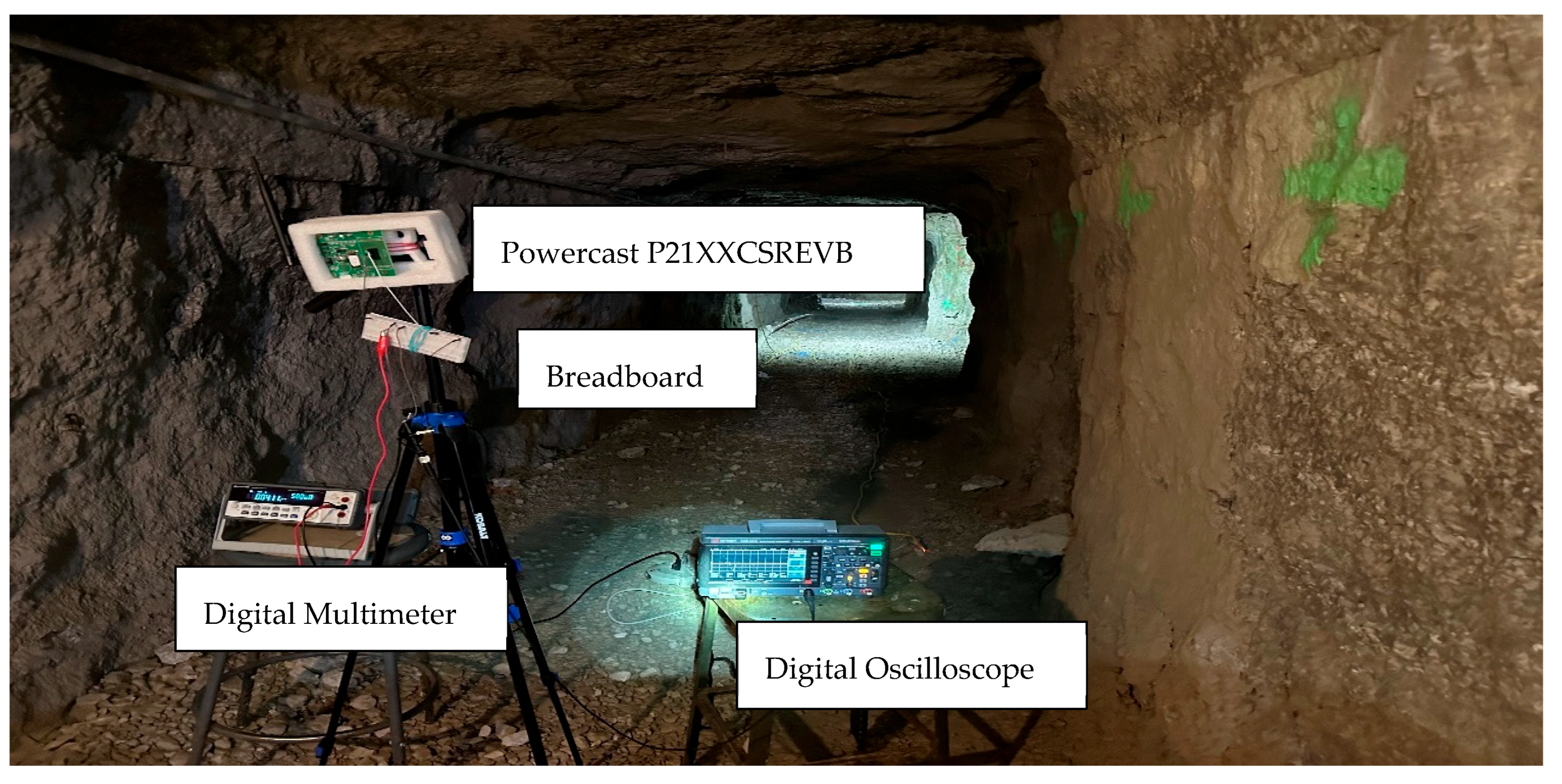
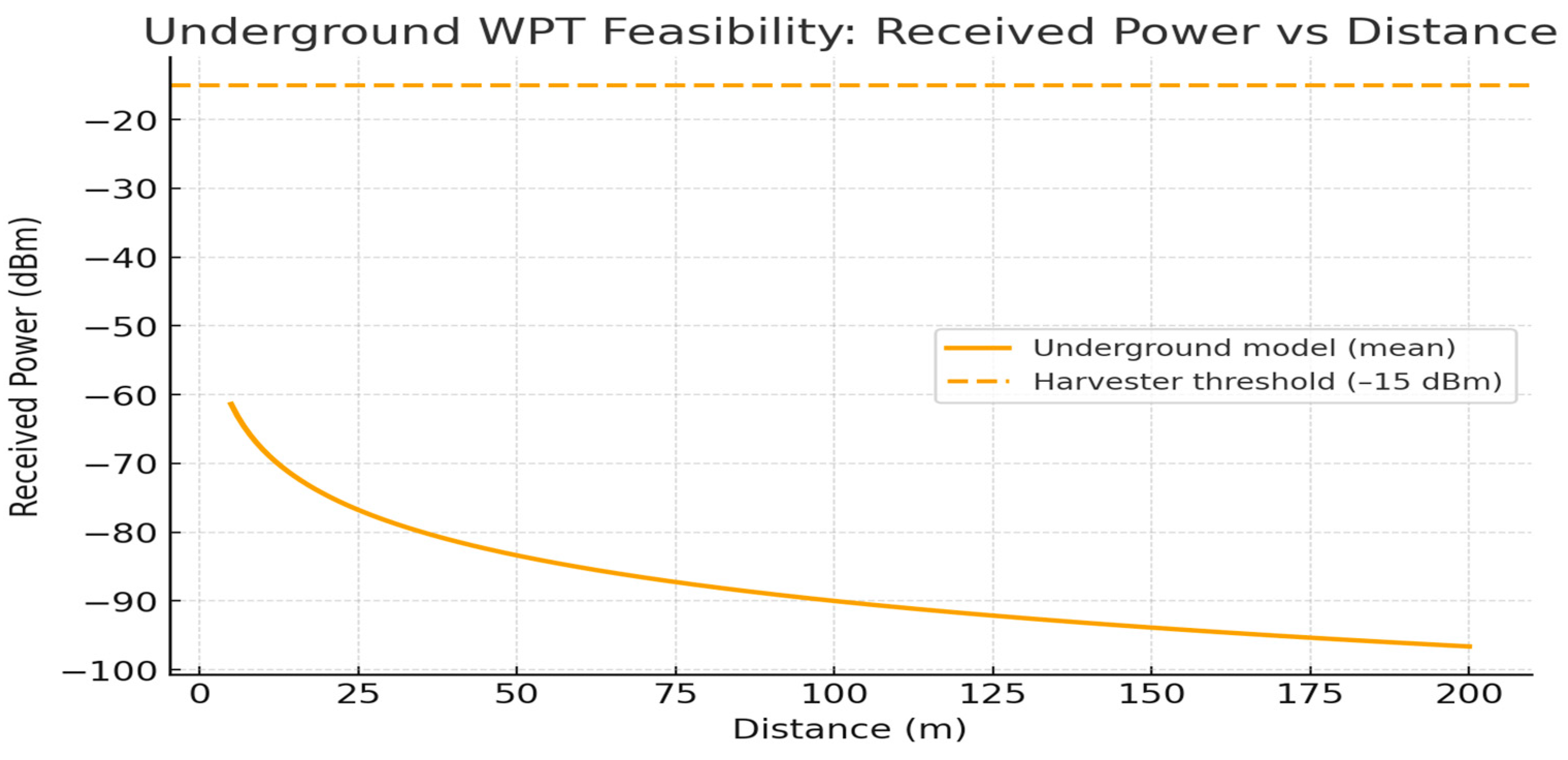

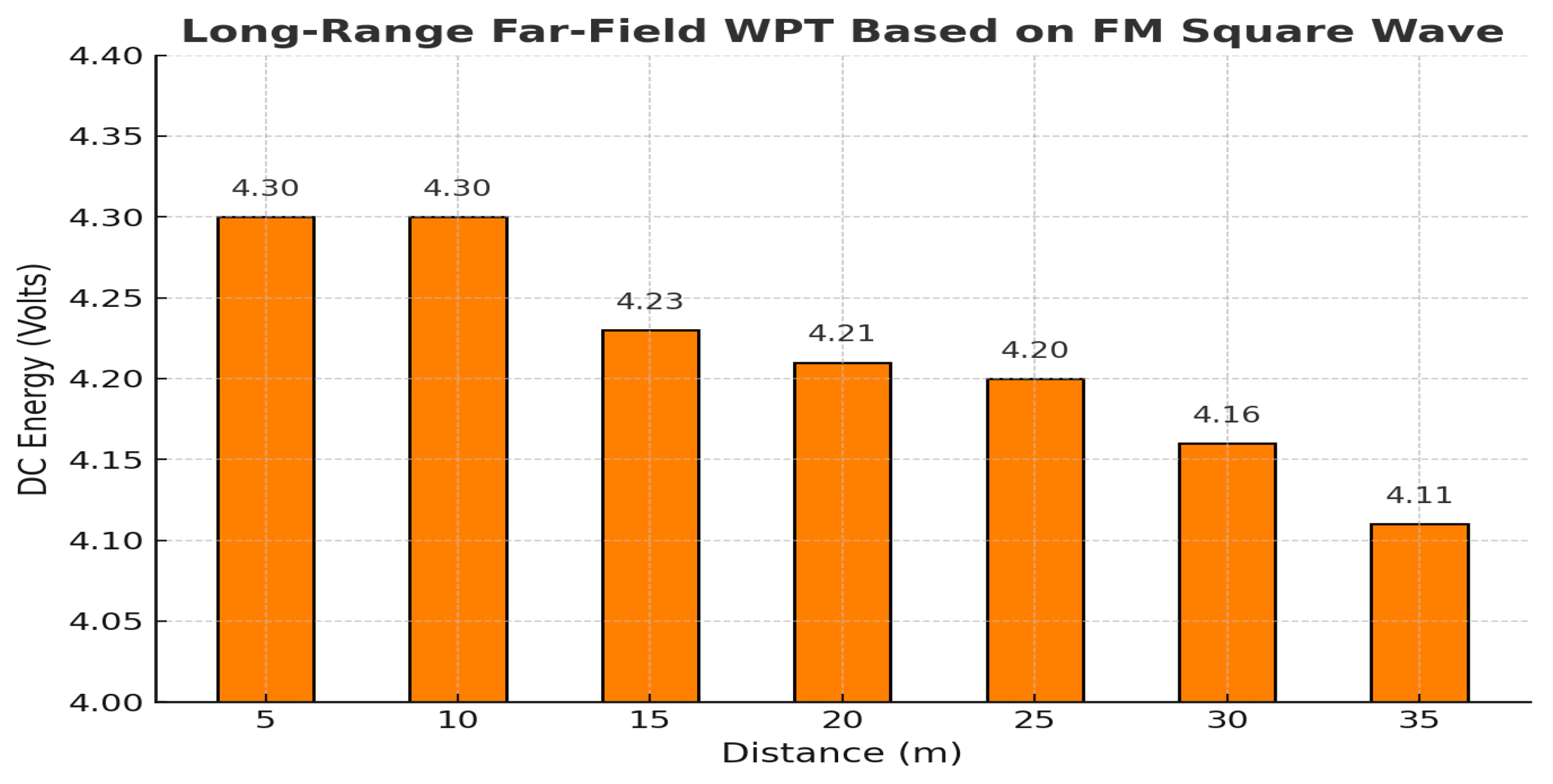
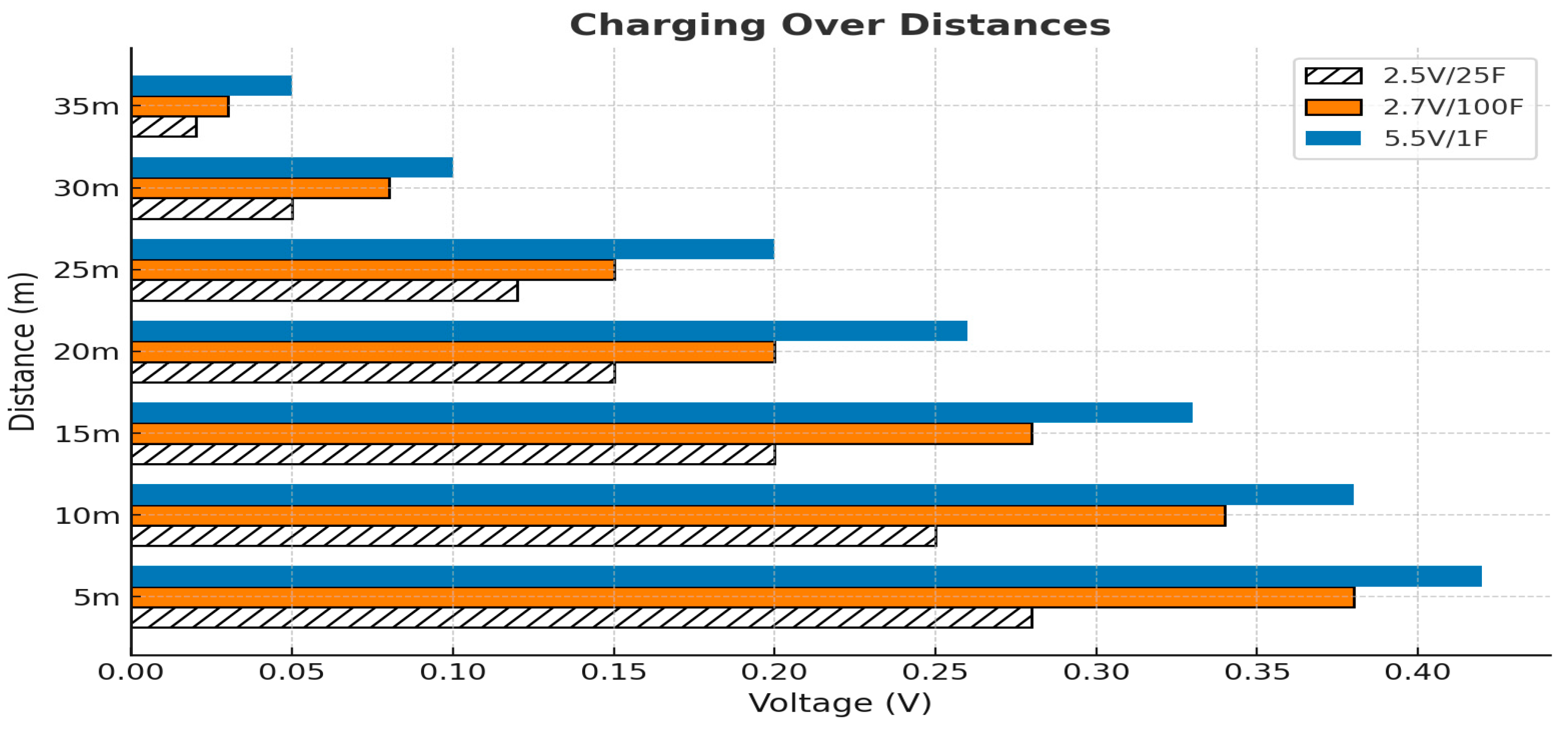
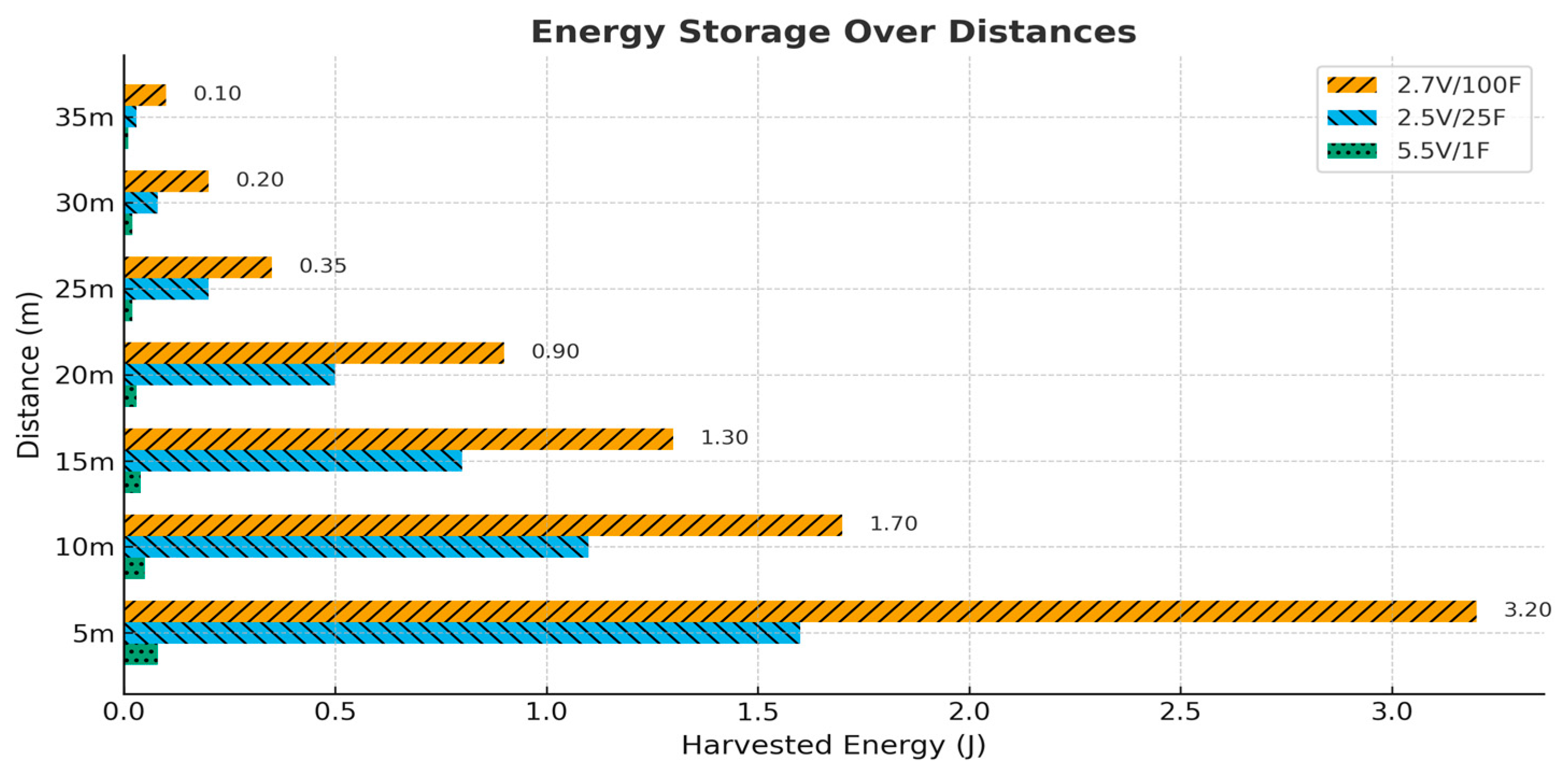


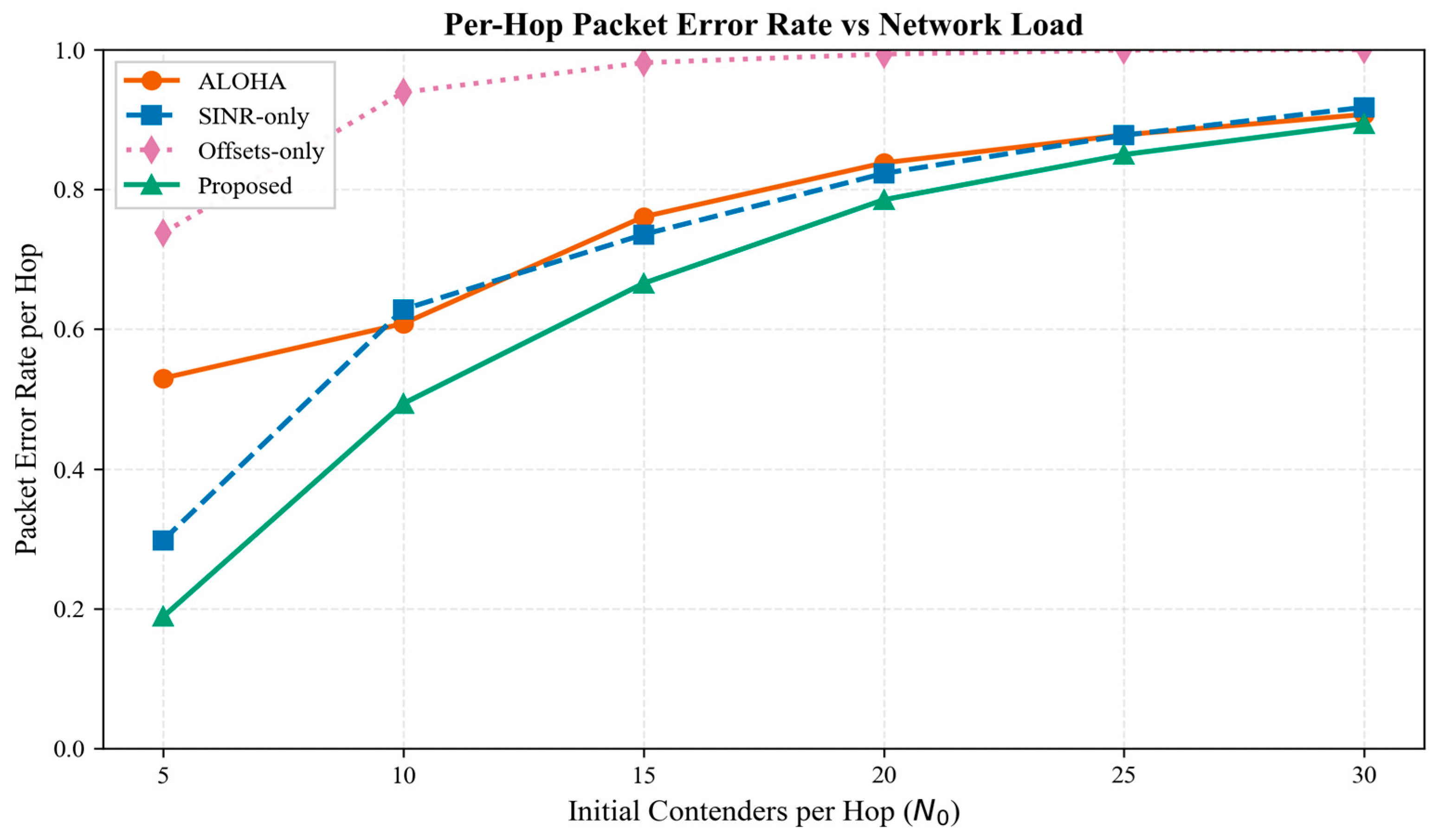

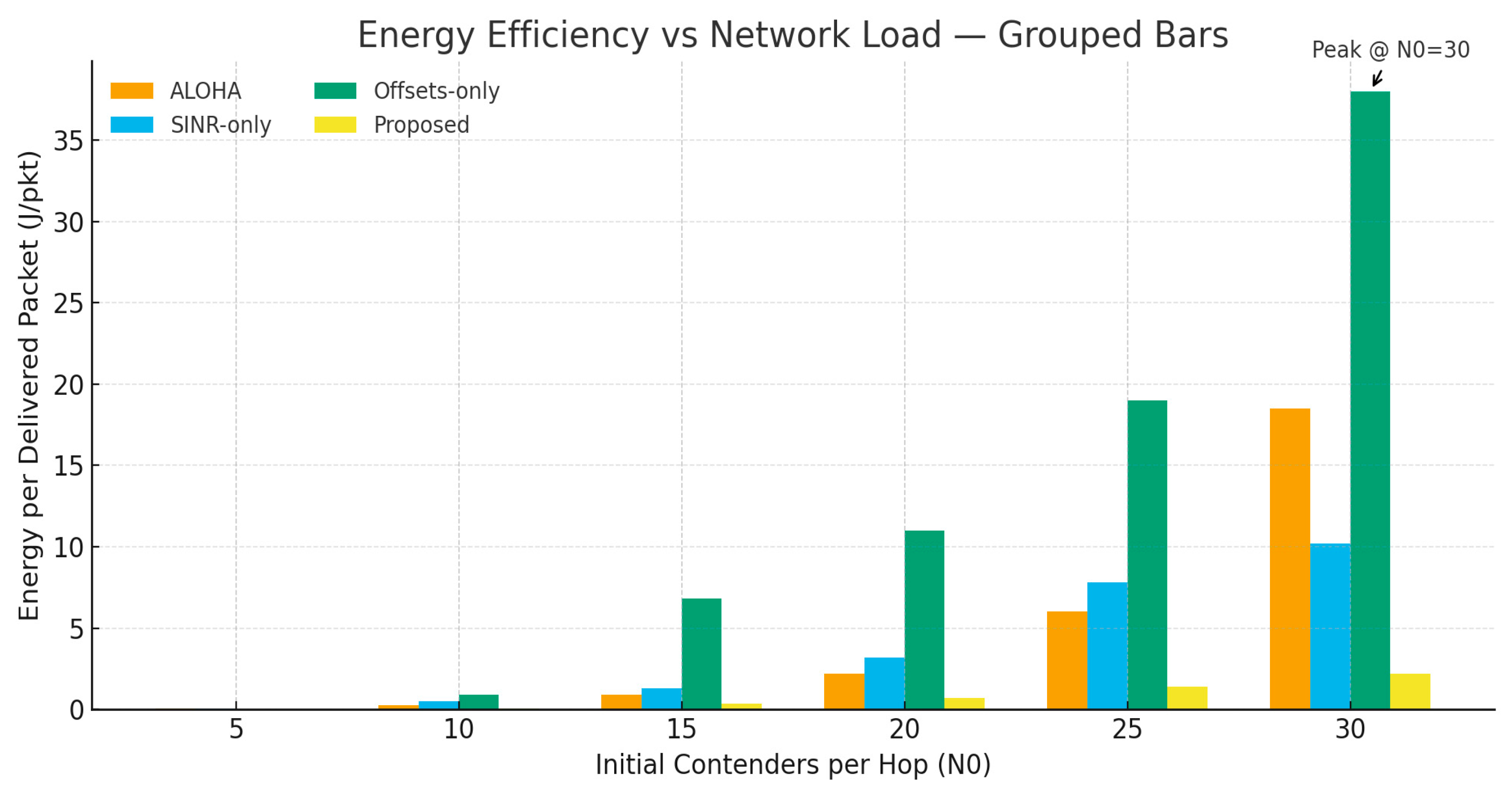
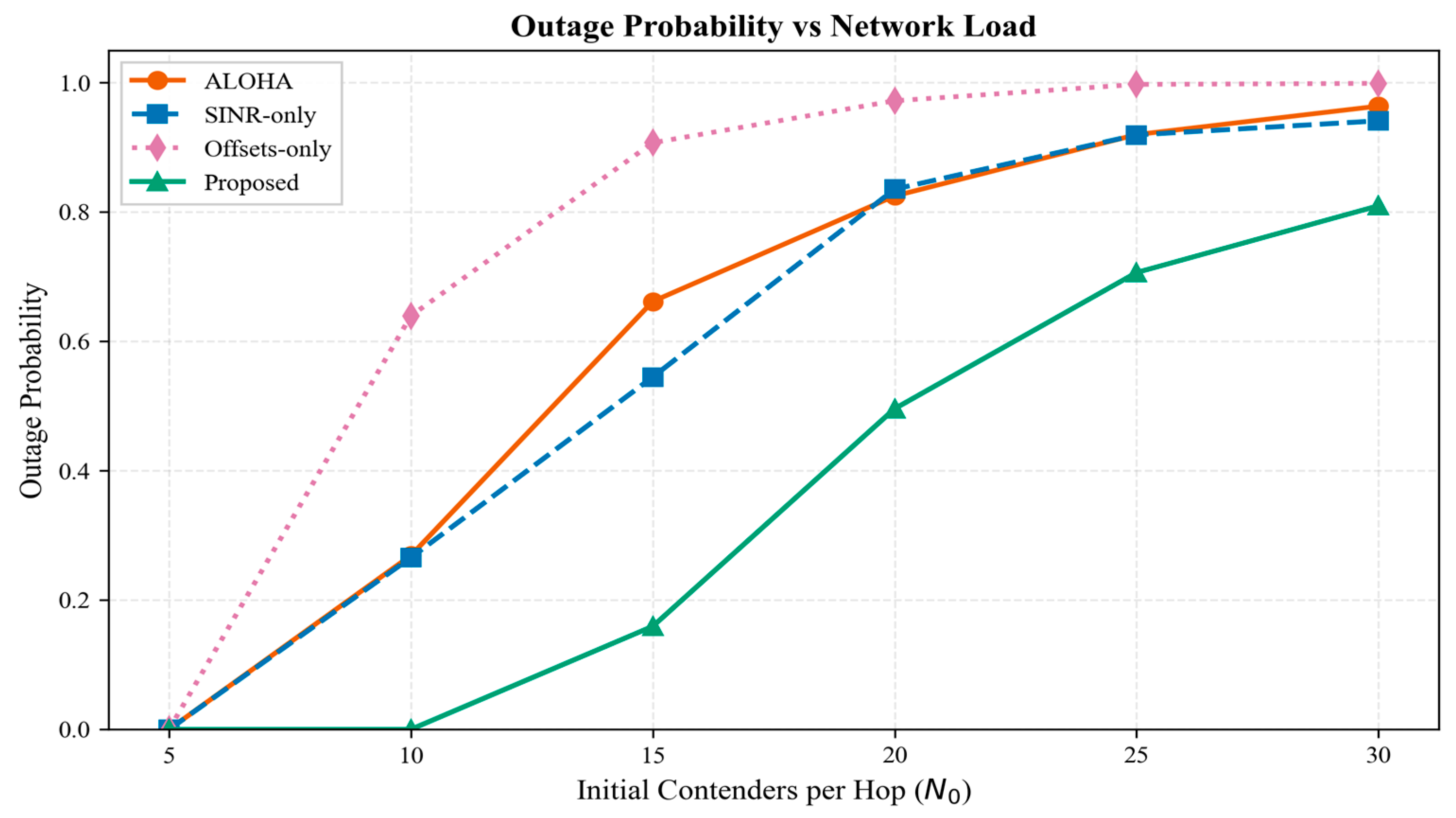
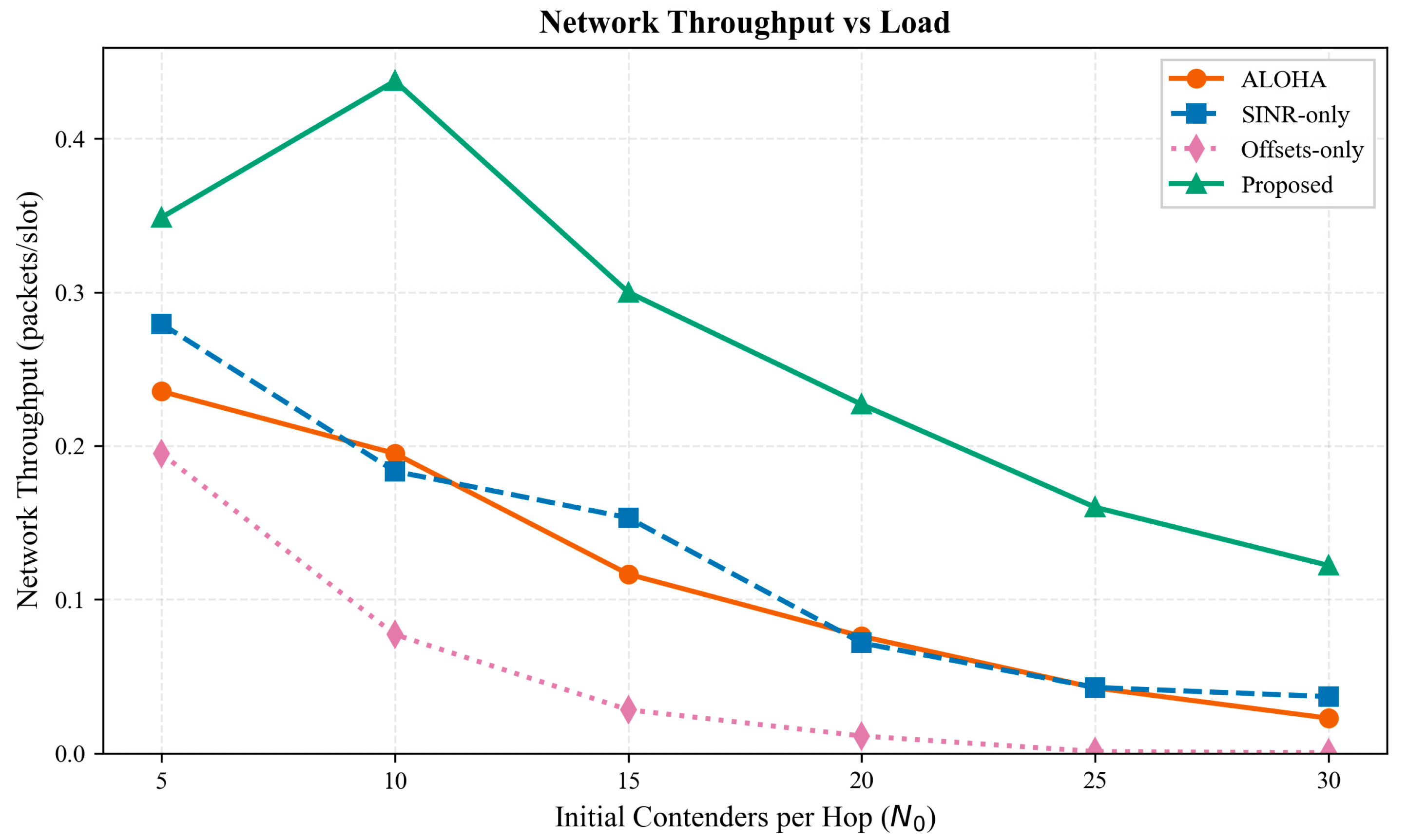
| Category | Baseline Algorithm/Reference | Key Features | Key Differences vs. Proposed Protocol |
|---|---|---|---|
| Access-only | ALOHA LoRa/LoRaWAN (Polonelli et al., 2019 [14]; Ibrahim et al., 2020 [15]). | Random channel access; no coordination; all nodes transmit independently using fixed PHY. | Suffer high collision rate and poor scalability under concurrent traffic; no timing offsets, no SINR adaptation, and no RF-energy harvesting awareness. The proposed method introduces deterministic offsets, SINR-aware PHY selection, and energy gating to prevent energy-starved transmissions. |
| Link-aware | Adaptive Data Rate (ADR)/SINR-Only Adaptation. (Kufakunesu et al., 2020 [16]; Serati et al., 2022 [17]). | Adjusts spreading factor (SF), bandwidth (BW), and coding rate (CR) using measured SINR; no coordination between nodes. | Improves link budget but cannot avoid collision in concurrent transmission. Proposed method integrates SINR adaptation into the scheduler and couples it with offset calculation, ensuring both PHY efficiency and collision control. |
| Scheduling/Offset | Multi-Hop Real-Time LoRa (RT-LoRa) (Tran et al., 2022 [8]). | Slot-based transmission scheduling to reduce collisions; fixed PHY; topology-driven slot updates | Lacks adaptability to dynamic interference and harvested energy conditions. The proposed method derives timing offsets analytically from collision probability ( ) and interference window and dynamically updates per-hop PHY and offset based on SINR and relay set. |
| Flooding/Concurrent | LoRaHop (Tian et al., 2023 [18]), JMAC (Escobar et al., 2020 [19]) | Nodes flood packets concurrently, exploiting capture effect; minimal routing overhead. | CT flooding assumes synchronized clocks and battery-powered nodes. The proposed design integrates RF-energy harvesting and safe timing offsets that limit destructive interference, enabling energy-sustainable CT in underground conditions. |
| Structured Mesh/Tree | Static parent–child (cluster-based) routing; topology fixed or slow to adapt; no concurrent forwarding. | Fails during disasters when cluster heads or gateways are destroyed. Proposed method employs flooding-based forwarding with TTL-bounded propagation and adaptive relay selection, maintaining network connectivity even under partial collapse. |
| Step 1: Compute candidates. Build by retaining neighbors with or and within a hop-limit/TTL constraint. |
| Step 2: Try unicast. Evaluate for the top -K neighbors by path loss or PRR. If the best satisfies , choose unicast. |
| Step 3: Escalate to dual. If unicast fails the reliability test or yields high EPD, examine the best pairs. If any pair satisfies , choose the minimum-EPD pair. |
| Step 4: Escalate to small set-flood. If dual fails, run a greedy subset selection up to to reach with minimal . |
| Step 5: Energy-aware tie-break. When two modes meet prefer the one with lower EPD. If EPDs are within a small slack prefer the smaller set to reduce channel load. |
| Device/Software | Description |
|---|---|
| Laptop | HP Intel(R) Core (TM) i5-1035G1 CPU @ 1.00GHz 1.19 GHz, Windows 10. |
| Vector Signal Generator | VSG60A 6GHz—Signal Hound hardware, VSG60 Signal Generation Software (VSG60 Software 64-bit). |
| Transmit Antenna | 880–960 MHz high gain directional 11 dBi Yagi |
| Receiver Antenna | VERT900 vertical antenna omnidirectional, gain 3 dBi. |
| WPT Receiver | Powercast P21XXCSR-EVB. |
| Power Amplifier (PA) | 880 MHz- 960 MHz, 12 V/6.8 A, 26 dB Gain, 20 W RF power, Class AB |
| Oscilloscope | KEYSIGHT DSOX1204A. |
| Digital Multimeter | Gw INSTEK GDM-8341. |
| Connectors | Laptop to VSG60A: USB2.0, VSG60A to PA: SMA plug male pin To SMA plug male connector -TNC male connector, WPT receiver to Oscilloscope: jumper cables. |
| DC power supply | 30 V/10A DC. |
| Component | Without PA | With 20 W PA |
|---|---|---|
| Base transmitter | 10 dBm | 10 dBm |
| PA gain | 0 dB | 26 dB |
| PA output power | 10 dBm | 35.5 dBm |
| Post-PA cable loss | 0.5 dB | 0.3 dB |
| Transmit antenna gain | 11 dBi | 11 dBi |
| EIRP | 20.5 dBm | 46.2 dBm |
| Power gain from PA | — | 25.7 dB |
| Distance (Meters) | 2.5 Volts 25 F | 2.7 Volts 100 F | 5.5 Volts 1 F | ||||||
|---|---|---|---|---|---|---|---|---|---|
| Time (s) | Volt (V) | Energy (J) | Time (s) | Volt (V) | Energy (J) | Time (s) | Volt (V) | Energy (J) | |
| 5 | 120 | 0.250 | 1.71125 | 120 | 0.37 | 3.125 | 120 | 0.44 | 0.0968 |
| 10 | 120 | 0.180 | 1.12500 | 120 | 0.3 | 1.62 | 120 | 0.35 | 0.06125 |
| 15 | 120 | 0.100 | 0.60500 | 120 | 0.22 | 0.5 | 120 | 0.24 | 0.0288 |
| 20 | 120 | 0.060 | 0.18000 | 120 | 0.12 | 0.18 | 120 | 0.19 | 0.01805 |
| 25 | 120 | 0.090 | 0.08000 | 120 | 0.08 | 0.405 | 120 | 0.1 | 0.005 |
| 30 | 120 | 0.009 | 0.00061 | 120 | 0.007 | 0.00405 | 120 | 0.01 | 0.00005 |
| 35 | 120 | 0.015 | 0.00005 | 120 | 0.002 | 0.01125 | 120 | 0.01 | 0.00005 |
| Seconds | 0 | 5000 | 10,000 | 15,000 | 20,000 |
| Minutes | 0 | 83.33 | 166.67 | 250 | 333.33 |
| Hours | 0 | 1.39 | 2.78 | 4.17 | 5.56 |
| Voltage | 2.73 | 2.64 | 2.61 | 2.58 | 2.57 |
| Voltage drop | 0 | 0.9 | 0.3 | 0.3 | 0.1 |
| Metric | Symbol/Unit | How Measured | Acceptance Target |
|---|---|---|---|
| End-to-End Delivery | EDR | Unique packets accepted at sink/packets generated | for disaster bursts |
| Packet Error Rate per hop | 1- PRR at each hop from logs | at median hop | |
| End-to-End Latency (95th) | Sink accept timestamp—source tx timestamp (excluding duplicates) | e.g., 2–5 s | |
| Energy per Delivered Packet | Sum node TX/RX/overhead energy/unique delivered packets | Baseline (no offsets) | |
| Outage Probability | Fraction of epochs with insufficient energy to TX |
| Parameter | Value | Unit | Description |
|---|---|---|---|
| Network Topology Parameters | |||
| Hops count | 4 | Hops | Number of hops from source to destination |
| Nodes per hop | [5, 10, 15, 20, 25, 30] | Nodes | Variable load tested across different densities |
| Area size | 100.0 | meters | Network deployment area (100 m × 100 m) |
| Topology | Linear multi-hop | - | Sequential hop topology |
| Physical Layer Parameters | |||
| Pathloss Expo | 2.0 | - | Path loss exponent (α) |
| 3.0 | Watts | Maximum transmission power | |
| 0.1 | Watts | Minimum transmission power | |
| Watts | Additive White Gaussian Noise (AWGN) | ||
| 3.0 | dB | Target SINR threshold | |
| 1.995 | Linear | Target SINR | |
| Bandwidth | Hz | Channel bandwidth (1 MHz) | |
| MAC Layer Parameters | |||
| Slot duration | 0.01 | seconds | Time slot duration (10 ms) |
| Guard time | 0.0005 | seconds | Guard interval (0.5 ms) |
| Max retransmissions | 10 | attempts | Maximum retransmission attempts before drop |
| Traffic Generation Parameters | |||
| Packet generation probability | 0.2 | probability | Packet generation probability per slot |
| Traffic model | Poisson | - | Random packet arrivals |
| Source nodes | Hop 0 only | - | Only source nodes generate traffic |
| Packet size | 25 | Bytes | Fixed-size packets |
Disclaimer/Publisher’s Note: The statements, opinions and data contained in all publications are solely those of the individual author(s) and contributor(s) and not of MDPI and/or the editor(s). MDPI and/or the editor(s) disclaim responsibility for any injury to people or property resulting from any ideas, methods, instructions or products referred to in the content. |
© 2025 by the authors. Licensee MDPI, Basel, Switzerland. This article is an open access article distributed under the terms and conditions of the Creative Commons Attribution (CC BY) license (https://creativecommons.org/licenses/by/4.0/).
Share and Cite
Anabi, H.K.; Frimpong, S.; Madria, S. Energy-Harvesting Concurrent LoRa Mesh with Timing Offsets for Underground Mine Emergency Communications. Information 2025, 16, 984. https://doi.org/10.3390/info16110984
Anabi HK, Frimpong S, Madria S. Energy-Harvesting Concurrent LoRa Mesh with Timing Offsets for Underground Mine Emergency Communications. Information. 2025; 16(11):984. https://doi.org/10.3390/info16110984
Chicago/Turabian StyleAnabi, Hilary Kelechi, Samuel Frimpong, and Sanjay Madria. 2025. "Energy-Harvesting Concurrent LoRa Mesh with Timing Offsets for Underground Mine Emergency Communications" Information 16, no. 11: 984. https://doi.org/10.3390/info16110984
APA StyleAnabi, H. K., Frimpong, S., & Madria, S. (2025). Energy-Harvesting Concurrent LoRa Mesh with Timing Offsets for Underground Mine Emergency Communications. Information, 16(11), 984. https://doi.org/10.3390/info16110984







